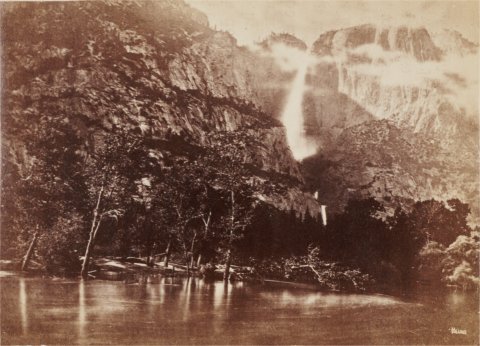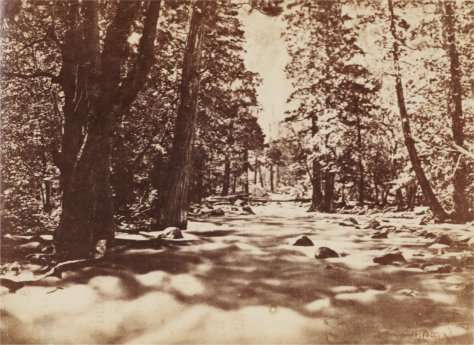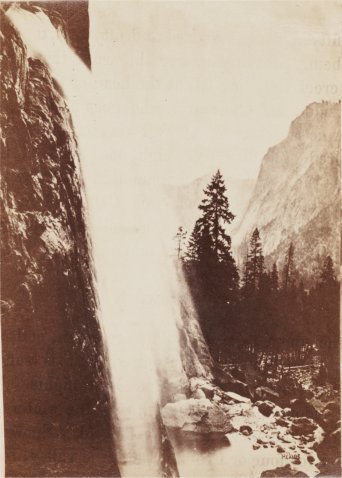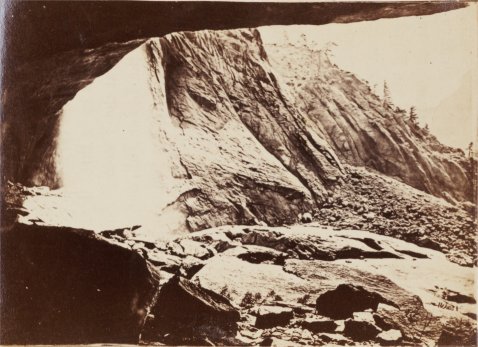
VI. Yosemite Falls. Upper Fall, 1,500 feet; Cascades and Rapids, 650
feet; Lower Fall, 400 feet; total, 2,550 feet.
| Online Library: | Title | Author | California | Geology | History | Indians | Muir | Mountaineering | Nature | Management |
Yosemite > Library > Wonders & Beauties > Yosemite Fall >
Next: Fissure • Contents • Previous: Cathedral Rock

VI. Yosemite Falls. Upper Fall, 1,500 feet; Cascades and Rapids, 650 feet; Lower Fall, 400 feet; total, 2,550 feet. |
Five miles from the point where the trail strikes the valley, on the north side, is the Yosemite Fall, where the creek of the same name, in three cataracts, jumps down 2,550 feet. The upper fall is 1,500 feet high, and is a third of a mile back from the valley, in a gorge; the second fall is rather a succession of cascades, measuring in all six hundred and twenty-six feet, after which comes the third fall, four hundred feet high, below which is a talus, two hundred feet high. There is an appearance here of confiderable erosion. Below the lower fall the stream divides into three branches, and one of these is straight for half a mile, and is lined with tall trees, so as to present a beautiful vista. It is called Cascade Avenue, because of numerous little cascades in its course. It is represented by one of the photographs. In the cañon between the Upper and Lower Falls, there are very fierce gusts of wind, so strong that visitors frequently find difficulty in catching breath, and the spray sweeps down almost in showers. Most of the water of the Upper Fall breaks into mist and spreads out gradually, from thirty yards at the top of the cliff to a hundred yards at the bottom, The creek goes nearly dry in September, and it is not more than forty yards wide and four feet deep at its best, so the bulk of water is small. The general impression is, that the fall is not an important part of the attractions of the valley, and the time for a visit should be selected without special reference to the fulness of the streams. The photograph of the main fall was taken near Sentinel Hotel.
At the base of the Upper Fall, on the west side of it, is a cavern eight feet high, three hundred feet wide across the mouth, and thirty feet deep horizontally. It can only be reached in the dry season, and then by walking across from the east on a ledge of rock about twenty feet wide, upon which the water strikes with great force when the stream is full. A photographic view of the fall, as seen from this cave, is given.
Horace Greeley, who saw the fall in August, says:
“The fall of the Yosemite, so called, is a humbug. It is not the Merced river that makes this fall, but a mere tributary trout brook, which pitches in from the north by a barely once-broken descent of 2,600 feet, while the Merced enters the valley at its eastern extremity, over falls of six hundred and two hundred and fifty feet. But a river thrice as large as the Merced at this season would be utterly dwarfed by all the other accessories of this prodigious chasm. Only a Mississippi or a Niagara could be adequate to their exactions. I readily concede that a hundred times the present amount of water may roll down the Yosemite fall in the months of May and June, when the snows are melting from the central ranges of the Sierra Nevadas, which bound this abyss to the east; but this would not add a fraction to the wonder of this vivid exemplification of the Divine Power and Majesty. At present, the little stream that lea down the Yosemite, and is all but shattered to mist by the amazing descent, looks like a tape line let down from the cloud-capped hight to measure the depth of the abyss.”
On the other hand, Professor Whitney says:
”The traveler who has not seen the Yosemite when its streams are full of water, has lost if not the greater part at least a large portion of the attractions of the region, for so great a variety of cascades and falls as those which leap into this valley from all sides has, as we may confidently assert, never been seen elsewhere; both the Bridal Veil and the Nevada fall being unsurpassed in some respects, while the Yosemite fall is beyond anything known to exist, whether we consider its hight, or the stupendous character of the surrounding scenery.”

VII. Lower Yosemite Fall, from Cascade Avenue; Fall 400 feet high. |

VIII. Base of Lower Yosemite Fall, at low water. |

IX. Base of Upper Yosemite Fall, from the Yosemite Cave. |
Next: Fissure • Contents • Previous: Cathedral Rock
| Online Library: | Title | Author | California | Geology | History | Indians | Muir | Mountaineering | Nature | Management |
http://www.yosemite.ca.us/library/yosemite_its_wonders_and_its_beauties/yosemite_fall.html